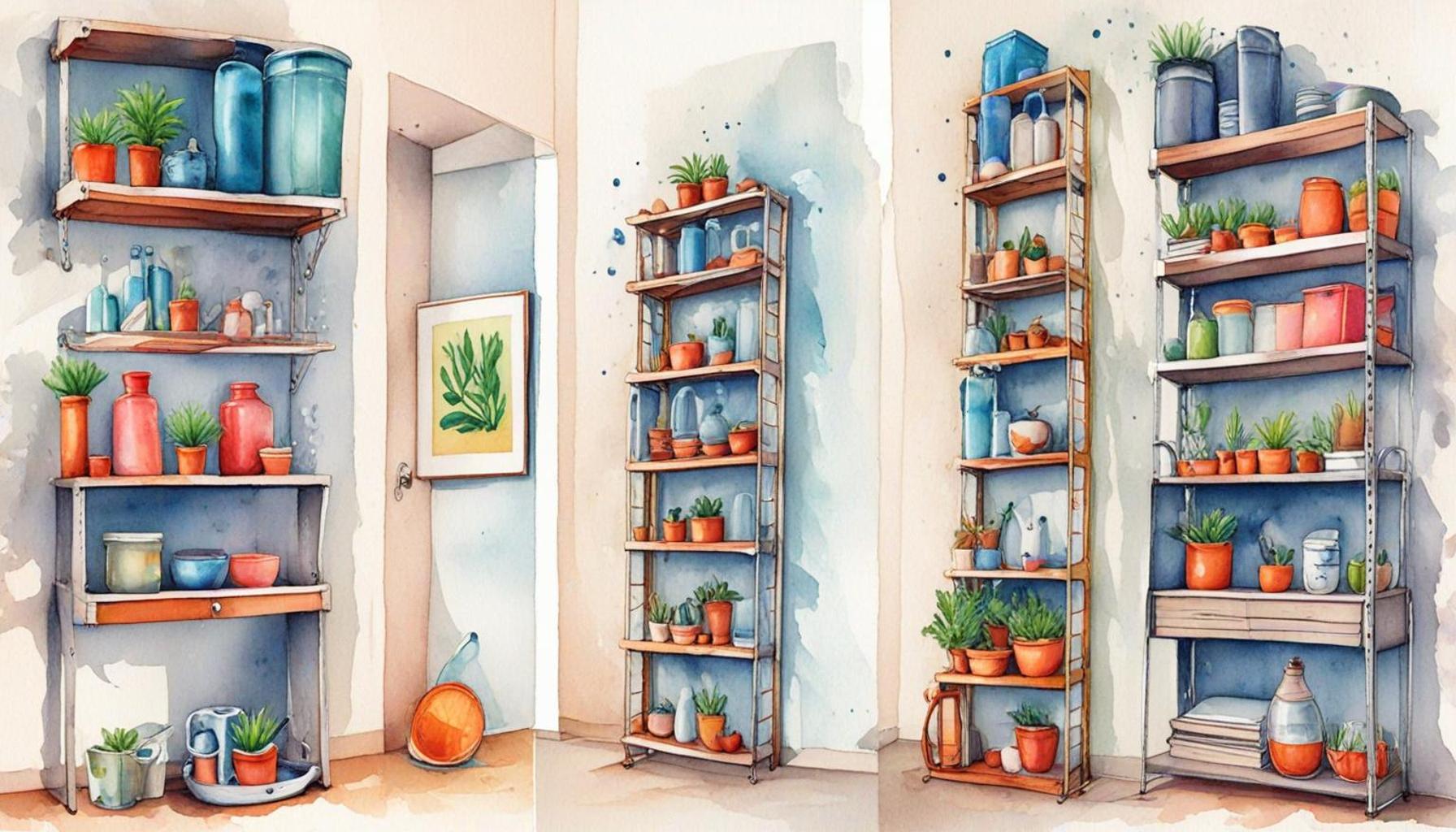The Importance of Transitional Space: Creating Functional Areas in Minimalist Environments

The Role of Transitional Spaces in Minimalist Design
As society leans increasingly towards a preference for minimalist design, the importance of transitional spaces demands greater attention. Often seen as mere corridors or passageways, these areas are instrumental in connecting different functional zones. Recognizing their role can significantly enhance both the practicality and aesthetic value of any environment, especially in contemporary homes and working spaces.
Transitional spaces are not just physical zones; they embody the essence of flow within a layout. They facilitate movement and flow by creating pathways that guide the occupants from one area to another, which is crucial in reducing congestion and confusion. They enhance functionality by serving as natural organizers of space; consider how a well-designed hallway not only leads you to the next room but can also serve as a gallery for artwork or decorative lighting.
Visual interest is another hallmark of transitional spaces, achieved through contrast. For instance, a hallway painted in a vibrant hue can lead to more subdued, neutral rooms, generating a sense of surprise and intrigue. This technique can be especially effective in homes with open-concept designs, where the transitional space acts as a canvas that showcases a stylistic shift from one area to another.
In practical terms, modern homes and offices may utilize transitional spaces such as:
- Hallways, which not only connect rooms seamlessly but can also serve as vital storage areas or display spaces that reflect the aesthetic choices of the inhabitants.
- Entryways that provide a welcoming atmosphere, perhaps using minimalist benches or sleek console tables that accentuate your design ethos while serving practical purposes.
- Open-concept areas that effectively blur the boundaries between indoor and outdoor environments, allowing natural light to flow unchecked and creating a harmonious connection with nature.
By thoughtfully integrating these transitional spaces within a minimalist design framework, architects and designers can cultivate an atmosphere that is both stylish and functional. The challenge lies in maintaining balance; too many items in these crossover areas can lead to clutter, undermining the very essence of minimalism. Therefore, an exploration into the design of these spaces is essential for maximizing efficiency and finding artistic expression within everyday living.

As we dive deeper into this exploration, we encourage you to envision the potential of transitional spaces within your own environment. Understanding their design holds the promise of unlocking new dimensions in the pursuit of a balanced, minimalist lifestyle.
DISCOVER MORE: Click here to learn about intentional design
Enhancing Functionality Through Transitional Spaces
In the realm of minimalist design, the term “transitional space” transcends its conventional interpretation. Rather than simply a passage between two areas, these spaces are pivotal in promoting functionality and enhancing the overall aesthetic of a home or office. Understanding how to utilize and design transitional spaces can profoundly shape the experience of living and working in minimalist environments.
One of the critical aspects of transitional spaces is their ability to facilitate movement smoothly and intuitively. A well-conceived transitional space functions as a bridge, providing an unobtrusive flow through differing areas. For instance, a thoughtfully designed hallway not only directs foot traffic but can be transformed into a gallery that showcases family photos or modern art, blurring the lines between utility and beauty. This design philosophy aligns perfectly with the minimalist ethos of doing more with less, ensuring that each element in the space serves a dual purpose.
Moreover, transitional spaces can be instrumental in maintaining order and reducing visual clutter, particularly in open-concept homes where boundaries are often blurred. A clean and spacious entryway can help anchor a home, offering a sense of welcome while subtly delineating the shift from the outside world. Utilizing practical furniture such as sleek benches or well-placed coat hooks not only adds to the aesthetic but also provides essential storage solutions that keep the area organized.
Another remarkable component of transitional spaces is their ability to connect indoor and outdoor environments, which is particularly relevant in California and other states where outdoor living is cherished. Features such as sliding glass doors can expand the living space, inviting natural light and fresh air while reinforcing the minimalist principle of harmony with nature.
To further illustrate how transitional spaces can be designed effectively, consider the following elements:
- Lighting: Using distinct lighting fixtures in transitional spaces can create ambiance and highlight these areas, turning them into focal points in minimalist design. A unique pendant light in a hallway can make for a stunning conversation starter.
- Color and Texture: A strategic use of color and texture can differentiate transitional spaces from adjacent areas, adding visual intrigue without overwhelming the senses. For example, a bold accent wall can enliven a muted corridor.
- Furniture Arrangement: The placement of furniture should encourage movement. Sufficient space between furnishings not only eases passage but also creates a sense of openness, which is essential in minimalist environments.
As we explore the possibilities of transitional spaces in minimalist settings, it’s imperative to recognize that their design extends beyond mere connectivity. They represent a philosophy of living that values simplicity, elegance, and functionality. By embracing these concepts, homeowners and designers can elevate their spaces, crafting environments that not only fulfill practical needs but also inspire a lifestyle rooted in minimalism.
Transitional spaces play a crucial role in the overall flow and functionality of minimalist environments. These areas, often overlooked, serve as essential connectors between distinct zones, ensuring a cohesive transition that enhances the spatial experience. By incorporating transitional spaces, one can achieve a sense of order and organization, crucial for minimalism, which aims to reduce clutter and maximize utility.When designed effectively, transitional spaces can facilitate not only movement but also interaction. For instance, a hallway that doubles as a gallery can be adorned with art pieces or personal photographs, making the journey from one room to another visually engaging and purposeful. Additionally, utilizing functional furniture, such as benches or shelving, can transform these spaces into multifunctional areas, accommodating both traffic and storage needs.Furthermore, the strategic use of lighting in transitional spaces can elevate the ambiance. Natural light, when allowed to filter through open designs or strategically placed windows, can create a welcoming atmosphere, drawing attention to these often-neglected zones. The addition of soft lighting fixtures can also enhance the mood and highlight the minimalistic aesthetic, emphasizing simplicity while ensuring comfort.Integrating elements such as plants or greenery into transitional areas can imbue a sense of life and vitality, softening the starkness often associated with minimalism. This not only contributes to the aesthetic appeal but also promotes well-being, as natural elements have been shown to reduce stress and enhance relaxation.To further understand how to utilize transitional spaces effectively, let’s explore the advantages these areas offer in the context of minimalist design. Below is a comprehensive table highlighting key categories and benefits:
| Category | Benefits |
|---|---|
| Space Efficiency | Maximizes usable area, minimizing waste. |
| Aesthetic Balance | Creates a visual flow, enhancing minimalist appeal. |
| Functional Versatility | Transforms spaces for multiple uses, like seating and storage. |
| Enhanced Connectivity | Encourages movement and interaction between spaces. |
Exploring these categories reveals not just the benefits of transitional spaces but also encourages a deeper inquiry into designing functional areas within minimalist environments. Through informed design choices, it’s possible to create transitional spaces that are not only practical but also enrich the user experience through thoughtful engagement and interaction.
DIVE DEEPER: Click here to learn more
Strategically Defining Spaces Through Design
Incorporating transitional spaces into a minimalist environment is not only about aesthetics; it’s about strategically defining areas that boost functionality and promote flexibility. As society gradually shifts towards smaller living spaces, especially in urban areas, the importance of these multifunctional zones becomes more pronounced. Transitional spaces offer a way to maximize utility without compromising the serenity that minimalist design aims to achieve.
One effective method for designing transitional spaces is the use of modular furniture. By integrating pieces that can be easily rearranged or repurposed, homeowners can create dynamic environments that adapt to different needs. For instance, a small dining area can pivot to accommodate work-from-home scenarios during the day and serve as an entertainment spot in the evening. This fluidity fosters a sense of comfort and minimizes the feeling of being confined, which is essential in modern urban living.
Another innovative approach to achieving functional transitional spaces is through the integration of smart technology. Known as smart homes, these spaces utilize automation to optimize comfort and efficiency. Features such as programmable lighting systems or climate controls can be seamlessly incorporated into transitional areas. For instance, a connected entryway can welcome you with a gentle lighting transition as you approach, enhancing both functionality and mood while reinforcing a sense of harmony—a hallmark of minimalist philosophies.
Furthermore, landscaping plays a crucial role in defining the boundaries of transitional spaces, particularly in homes with outdoor areas. Creating a seamless flow from indoor to outdoor environments encourages the extension of living spaces. The use of paving stones, similar colors, and natural materials can elegantly connect a patio to a living room, creating an inviting atmosphere that encourages mingling with nature. Whether it’s a small balcony adorned with plants or a spacious terrace, these areas can enhance the minimalist experience by providing tranquil retreats within the home.
In addition to using flexible furniture and technology, another significant aspect of designing transitional spaces lies in the mindful selection of materials. The choice of flooring, wall finishes, and textiles can influence the visual and tactile flow between spaces. For instance, a continuous flooring material, such as polished concrete or wood, helps dissolve the boundaries between spaces, creating an uninterrupted aesthetic. Meanwhile, choosing softer textiles in transitional zones can add warmth and comfort, promoting relaxation.
Architects and interior designers are also leaning towards biophilic design in transitional spaces. The incorporation of natural elements like indoor plants, natural light, or water features aims to connect inhabitants with nature, enhancing their well-being. This design trend is especially relevant in minimalist environments, where the focus is on intentionality—every element should serve a purpose. By prioritizing natural materials and shapes, transitional spaces can promote a sustainable lifestyle that aligns perfectly with a minimalist ethos.
Overall, the strategic design of transitional spaces is an essential element in creating functional areas within minimalist environments. Through modular furniture, smart technology, thoughtful landscaping, mindful materials, and biophilic design, these spaces transcend their traditional utility. They become vibrant areas that enhance living experiences, embodying the essence of minimalism: simplicity, functionality, and harmony.
DISCOVER MORE: Click here to learn about the art of letting go
Redefining Living with Transitional Spaces
In the pursuit of creating functional areas within minimalist environments, the significance of transitional spaces cannot be overstated. As urban living becomes increasingly confined to smaller footprints, understanding how to harness these multipurpose zones is essential for enhancing overall living quality. The blend of modular furniture, smart technology, thoughtful landscaping, and biophilic design contributes to a cohesive atmosphere that marries functionality with tranquility.
Moreover, these transitional spaces serve not just as physical connectors between areas but also as emotional and experiential canvases that impact daily life. By incorporating elements that facilitate flexibility and adaptability, residents can create environments that transform according to their needs, whether for work, relaxation, or social interactions. This adaptability is paramount in today’s fast-paced world where flexibility is a sought-after commodity.
In conclusion, it is crucial for homeowners and designers to embrace the potential of transitional spaces. With thoughtful design choices, these areas can evolve from strictly utilitarian spaces into vibrant hubs that foster creativity and community spirit. The exploration of transitional spaces not only inaugurates a new era of minimalist living but also encourages deeper connections with the environment and those around us. In this constant quest for simplicity and purpose, transitional spaces are the key to unlocking a harmonious balance in our homes, allowing us to thrive in ever-changing urban landscapes.


